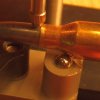RoadKill
Active Member
Those 'bout got to be the thinnest of neck walls allowed in any factory SAAMI spec 6.5 Creedmoor brass to have a standard non-neck bushing die not size down the neck OD so far that expanding the neck ID is not necessary. It's either that or you're butchering the jacket by using the bullet as the expander during seating.
What's your loaded round neck diameter?
What's a fired case neck OD measure fresh out the chamber?
Without a bullet, what's the neck OD after sizing without expanding?
What's your loaded round neck diameter?
What's a fired case neck OD measure fresh out the chamber?
Without a bullet, what's the neck OD after sizing without expanding?
Last edited:

